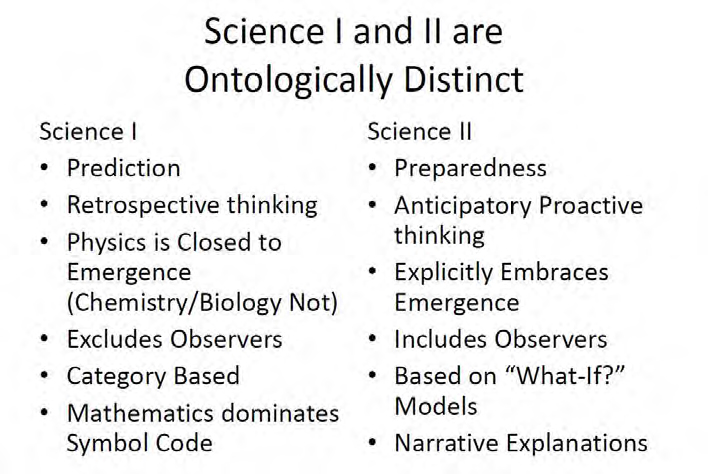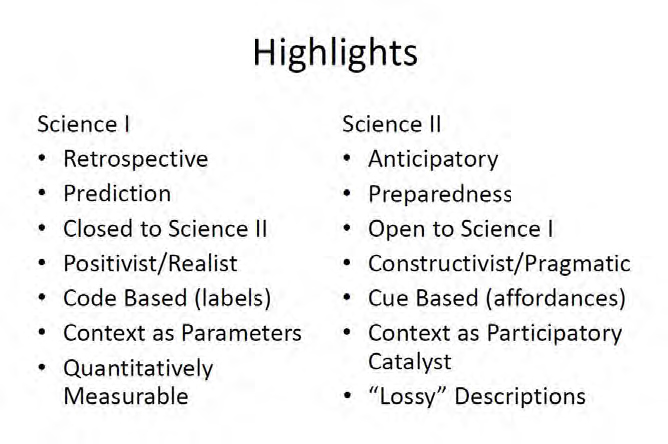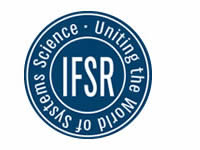Proceedings of the IFSR Conversation 2012, St. Magdalena, Linz, Austria
|
Stuart Umpleby, USA (umpleby@gmail.com) Jerry Chandler, USA (jerry_lr_chandler@mac.com) Allenna Leonard, CND (allenna_leonard@yahoo.com) Michael Lissack, USA (michael.lissack@gmail.com) Helmut Loeckenhoff, GE (loeckenhoff.hellk@t-online.de) Tatiana Medvedeva, RU (tmedvedeva@mail.ru) Leonie Solomons, AUS (leonie.solomons@gmail.com) |
Abstract: For the past century, Western science has focused on the idea that the world is organized around discrete objects which aggregate and have simple relationships. The paradigm is that of physics. All things should be explainable through rules, laws, and algorithms. The observer is not a part of the observation since the “things” themselves constitute reality. Despite the successes which this frame has produced, it has a serious deficiency: How is it that the actions and behaviors of sentient creatures are best described by rules for non-thinking objects? How is it that context is deemed to not matter? And what about complexity? Those relationships which cannot be described by the simple? The physics based frame has no answer and instead discards these issues with the magic words: Ceteris paribus. But we do not live in a Ceteris paribus world. Thus, arises the need for some other kind of science..
Keywords: Science, Physics, Systems, Models, Frames of Reference
Our mission was to begin to articulate a new perspective on science. Most observers believe that science is a rigorous expansion of common sense. Common sense is defined by Merriam-Webster as, “sound and prudent judgment based on a simple perception of the situation or facts.” It is believed (by both common sense and science) that in most cases that simple perception is “good enough”. But, simple perceptions fail to adequately capture the import of context or situation. They are poor at reflecting more than single order effects (where a leads to b). By relying on common sense, we are in effect relying on the assumption that simple perceptions are adequate for the task or judgment at hand. But are they?
Jay Forrester has noted: “While most people understand first-order effects, few deal well with secondand third-order effects. Unfortunately, virtually everything interesting lies in fourth-order effects and beyond.”
When simple perceptions are inadequate, then the need for tools that enable better access to “what, who, and how much” one needs to know becomes painfully obvious. Expanding upon common sense — either in the form of developing better tools for simple perceptions, better methods for simplifying complex perceptions, or better approaches for making judgments based on these simple perceptions just will not help in that portion of the world where “success” lies in developing an understanding of boundaries, constraints, and possibilities inherent in the interactions of large numbers of autonomous and semi-autonomous agents.
Many attempts have been made over the years to refine the notion of common sense — nearly all have run into the same obstacle: simple perceptions are oft times inadequate to capture what we need to know about a given situation or context in which we find ourselves. Our observation is that the current conceptions of science run into this same obstacle. Thus, arises the need to expand our repertoire beyond common sense, and beyond the simple – into a new realm for science – Science II

The Science II team at work. IFSR Conversations 2012
Task 1: Define the Issues
We began by raising issues:
- Social Science practitioners express frustrations/limitations with Science I
- General needs of a philosophy/epistemology of Science
- Specific needs for a hypothetical Science II
- What would that Science II include?
And went on to discuss frustrations and limitations regarding Science I (as expressed by individual members of the team):
- Methodological misfits
- Reliable prediction is not always possible
- Our ability to “see” and “express” certain phenomena is restricted by Science I in use
- The experience of “x” is not the same as the label “x”
- Ceteris paribus is nonsense
And with the Philosophy of Science as commonly used:
- Articulations of examples are most commonly physics based
- Despite the claims by physicists, other sciences cannot be reduced to physics or its equivalents without raising issues of both epistemology and ontology
- Other sciences have unique requirements demanding exact articulations
- Systems composed of thinking elements should not be described using methods developed for systems with non-thinking elements
This led to some initial conclusions. The basis for social sciences and design (pragmatic assumptions) is different from the “hard” sciences. There is a need to deal with ideas and communication in social systems. Thus, the Philosophy of Science needs expansion to include paths to potential logics of the social sciences. Example questions might include asking “What is the basic unit (individual, group, set, dynamic, environment, etc.?).” Thus Science II will require different languages than are commonly used in Science I. Science II will require different frameworks of thinking. Meta-level thinking is an opportunity which can create the need for new strategies of simplification so as to meet requisite variety.
Task 2: Expand upon Science as a Way of Thought
Generally science is understood as a methodical way of perceiving and cognizing, using observation, building mental models by learning. Beginning with consciousness and higher consciousness science developed from pre- stages (e.g. observation of natural cycles and adapting to them) in pre-history epochs to its actual highly sophisticated constitution. Early phases were closely enmeshed with magic and religious beliefs and rites to control natural events. Mesopotamia created with early topology and cosmology early mathematics to regulate agrarian cultures. Eastern philosophy contributed: India and China. In the medieval epoch formal Greek and pragmatic Roman philosophy, enriched by indigenous thought, grew into alchemy and astrology; the precursors of Post-Renaissance science and of the actual state of scientific research. Science has been and actually remains a learning system consisting of the triangle of the observing scientist, the topic of research and the modes of observation and conclusion.
Actual Science appears a human property to survive and develop emerging with changing inner and outer environments based on methodical learning. In Post-Renaissance science focused on Physics and the methodical rigorousity in physical experimenting, in concluding, in evaluation, validation etc. In the main stream methods derived from physical research where also applied to the non-physical sciences, namely to the life sciences, the anthropologies and humanities. They are addressed here summarily as social sciences. In the beginning the formal structures, the algorithms and the physical base of non-physical sciences were investigated, contributing to a formally/physically grounded understanding. Focusing nearly exclusively on that aspect it became obvious, that on that formal base social/societal objects could not be sufficiently be explored nor be understood nor be guided/controlled. The somewhat misleading term second order science denotes the return to the comprehensive conception of science as a means to cope with the world as described above. The formal physical base is complemented by indigenous modes of research fitting to the social (and other complex life) systems in question. In particular meaning is included. Accordingly epistemology is reconsidered and differentiated as to be adapted to the qualities of the actual object of the research. A movement ‘back to basics’ comprises virtually all sciences,. It responds also to extended scientific environments in the physical science as e.g. quantum physics, cosmology or eventually endo- and exo physics or the fractal nature of time and space experienced. Systems and cybernetics grounded and stimulated the process of scientific emergence, in particular systemics and cybernetics of second order. They acted and act like a hub in the network of rethinking and reinventing epistemology on the disciplinary and cross-disciplinary level. Their concepts supply the crucial points of epistemological departure for a transdisciplinary grounding of science.
Being aware of the above challenge the Team contributed by complementing the above from different focuses:
- Central to research is hypothesizing and modeling. Representation – based on labels and categories- is confined to deal with simple models not accounting for contextual complexity and change. Models to inquire complex topics need be more complex themselves, including narratives. They treat context not as a scaffold, but as a participating factor. They permit to include experiences without losing overview. The latter approach is called comprehension. Comprehension permits flexible adaptation and extension to the qualities of the actual topic. It provides e.g. the base for anticipation essential for life systems.
- Refined modelling takes care also of the co-action of the social/societal research object with the theory and epistemology employed. That proves necessary e. g. in consulting, politics, etc, that is generally in management and control. The role of the observer, that is the mental models of the -consultant, the strategist, the politician determine intent and measures. Well known is the soft systems methodology. Practice examples were discussed.
- Complexity (not only) in social systems is closely linked with meaning. Examples from inquiries in the feeling of well-being and expectations for the future reveal a most complex network governing the attitudes of people to the social/societal group they are member of. The existing –or the missing – participation on social community life turns out an essential factor of a vigorous social life. Examples were given.
- Reflecting the triad scientist – object – epistemology, investigating the role of the observer is assigned a pivotal role. The gradual deeper acknowledgement of the influence of the observer supports a critical rethinking of the ‘subjectivity’ and the proneness of results in societal research as to theories and models hypothesized.
- What is not in mathematics, cannot be in physics, nor in life systems, respectively in the epistemology of sciences. However, the mathematics of physical systems cannot one to one be applied to life systems. Investigation is needed whether an advanced, specific mathematics for life sciences needs to be developed from the physico-chemical base of life, e.g. the order of natural elements.
What Does This Imply for Science II?
We need to enrich the systems approach and reconcile the Eastern and Western approaches. It seems that Science II demands narratives. We used the example of Medical Heuristics (e.g. narratives told by physicians to patients). Because Science II includes Reflexive Anticipation more variety is needed in describing homeostasis and balance relationships. The very notion of “Best Practices” needs to be re-examined. Finally Science II needs to find ways to express circular causality.
We then tried to systematize our thoughts.
Task 3: We asked “What Happens When We Add the Observer to Science?”
Science I as traditionally understood has attempted to exclude the observer from having an active role in the scientific enterprise. Conclusions are supposed to be observer independent. Multiple experiments and the doctrine of falsification are supposed to render Science I objective and remove subjective bias. This notion was perhaps best captured in Karl Popper’s three worlds.

Figure 1: Based upon Karl Popper’s notion of three worlds, the arrow captures the question of adding
the observer to the Science I axis. IFSR Conversations 2012

Figure 2: We folded the right corner of the triangle in Fugure 1 and then labelled the resulting axes.
This chart allowed us to discuss in greater depth implications of the role of the obsever.. IFSR Conversations 2012

Figure 3: Our initial conclusion was that “adding the observer” resulted in a broader prhilosphy of
science rather than a replacement philosphy of science. Thus Science II functions in addition to
Science I. IFSR Conversations 2012
Task 4: Then we asked: what happens when we add feed-forward reasoning to Science?
- Language changes to include future tense
- Acting now in order to affect the future (telos, and why?)
- Spontaneity, Proactivity, and Anticipation play roles. All three act as circular inputs to goals. New learning cycles may emerge.
- Explanations cannot rest on labels but demand consideration of circular feedforward-feedback effects
- New relations are introduced and new critical thresholds must be considered
- Knowledge is expressed more as methods (how) and less as theory (what)
- Recognize the role of implicit knowledge
Task 5: Finally we asked: what happens when we add Will/Purpose to Science?
- Final cause becomes a basis of reasoning
- Consideration of the combinations and permutations of the affordances available becomes important
- Actors/observers/systems can be combined in multiple ways which give rise to potential conflicts of will
- Politics then may rear its ugly head
- The possibility of such conflicts demands the articulation of habitus so as to enable the exploration of commonalities and differences
Task 6: Recast the Ontology of Science and of Scientific Thought
When we pondered these questions we approached science as a process in evolvement. We observed that roughly four phases may be distinguished: 1st the ‘world’ how it is (simple positivism), 2nd the world as it is seen by the scientist (cybernetics II); 3rd the world how it has become: the dynamics of evolution, of complexity, of meaning; emergence. 4th the deep structures (networks, fractals, processes like dimensional re-entry). These can be pictured:

Figure 4: The ontology chart we developed to indicate the roles of both Science I and Science II. The
red area at the bottom lists qualities which distinguish the two .realms. IFSR Conversations 2012

Figure 5: While Figure 4 suggested that the realms were divided, Figure 5 is meant to emphasize
their interconnection. A mobius strip is a one dimensional continuous surface – so too are the
transitions between and amongst the realms of Science I and Science II. IFSR Conversations 2012
In conclusion we analyzed the differences between science (I) and second order science (Science II) as to their origins; historically and connected to the process of science as an emergence process. Why is Science II needed and, measured by the challenges, not yet sufficiently understood and solved? Only a new epistemology and ontology behind can adapt the potentials of science to deal with the looming natural, demographic and social singularities. Addressed are mainly but not exclusively societal, social and ecological challenges. If the observer and environments – in Science I but parameters – are included in the scientific process, participation, will and purpose (meaning) are added. The acknowledgement of feed forward, of the influence of the social habitus (specific social environments) enables anticipation, permits grounded guidance and control. The latter rises new problems: the abyss of politics, power play, of vested interests. Final cause is essential (anticipation), as is non-Aristotelian logic. Epistemology is implied deliberately as an active means and object of research. Research in itself is seen a learning process in a continuous line of learning and metalearning. Contexts remain not fix parameters, but become catalysts participating in the research process. The differences are reflected in a differing ontology in Science I and Science II.
Summary
The summary of our considerations is displayed in the two figures below

Figure 6: A summation of the distinctions between Science I and Science II. IFSR Conversations 2012
Science II constitutes a tool both for theory/model building and pragmatically problem solving.

Figure 7. Characteristics which distinguish the practice of science in the two realms. IFSR Conversations 2012

Team 2 Working together. IFSR Conversations 2012

Team 2 Working together. IFSR Conversations 2012
References:
Abductive Inference: Computation, Philosophy, Technology, by John R. Josephson; Susan G. Josephson (ISBN: 0521575451)
Anticipatory Systems, by Robert Rosen; Judith Rosen; John J. Kineman; Mihai Nadin (ISBN: 1461412684)
Belief Revision Meets Philosophy Of Science, by Erik J. Olsson (ISBN: 9048196086)
Boundaries And Barriers, by Anders Karlqvist; J.L. Casti (ISBN: 0201555700)
Carving Nature At Its Joints, by Michael O’Rourke; Joseph Keim Campbell; Matthew H. Slater (ISBN:
0262516268)
Causality And Explanation, by Wesley C. Salmon (ISBN: 0195108647)
Causality and Modern Science, by Mario Augusto Bunge (ASIN: B0007DWG70)
Ceteris Paribus Laws, by John Earman, Clark Glymour and Sandra Mitchell (ISBN: 9048161738)
Coherence in the Midst of Complexity: Advances in Social Complexity Theory, by Hugo Letiche, Michael Lissack , Ron Schultz (ISBN: 023033850X)
Context As Other Minds, by Talmy Givon (ISBN: 1588115933)
Creating Scientific Concepts, by Nancy Nersessian (ISBN: 0262515075)
Dynamics In Action: Intentional Behavior As A Complex System, by Alicia Juarrero (ISBN: 0262600471)
Explaining Explanation, by Lee McIntyre (ISBN: 0761858695)
Explaining Explanation, by David-Hillel Ruben (ASIN: B0086OJZQC)
How Scientists Explain Disease, by Paul Thagard (ISBN: 069105083X)
How The Mind Explains Behavior: Folk Explanations, Meaning, And Social Interaction (Bradford Books), by Bertram F. Malle (ISBN: 0262134454)
Human Nature And The Limits Of Science, by John Dupre (ISBN: 019926550X)
Induction and Deduction in the Sciences, by Friedrich Stadler (ISBN: 9048165555)
Memory Evolutive Systems; Hierarchy, Emergence, Cognition (Studies In Multidisciplinarity), by Andree C. Ehresmann; Jean-Paul Vanbremeersch (ISBN: 0444522441)
Representing Reality: Discourse, Rhetoric And Social Construction, by Jonathan Potter (ISBN: 0803984111)
Rethinking Explanation, by Johannes Persson; Petri Ylikoski (ISBN: 1402055803)
Science And Partial Truth: A Unitary Approach To Models And Scientific Reasoning (Oxford Studies In Philosophy Of Science), by Newton C.A. da Costa; Steven French (ASIN: B000R6V0QK)
Situations Matter, by Sam Sommers (ISBN: 1594488185)
The Semantic Turn, by Klaus Krippendorff (ISBN: 0415322200)
Theories Of Explanation, by Joseph Pitt (ISBN: 0195049713)
Theory And Truth: Philosophical Critique Within Foundational Science, by Lawrence Sklar (ISBN: 0199251576)
Thought And Language, by L.S. Vygotsky (ISBN: 0262720108)
